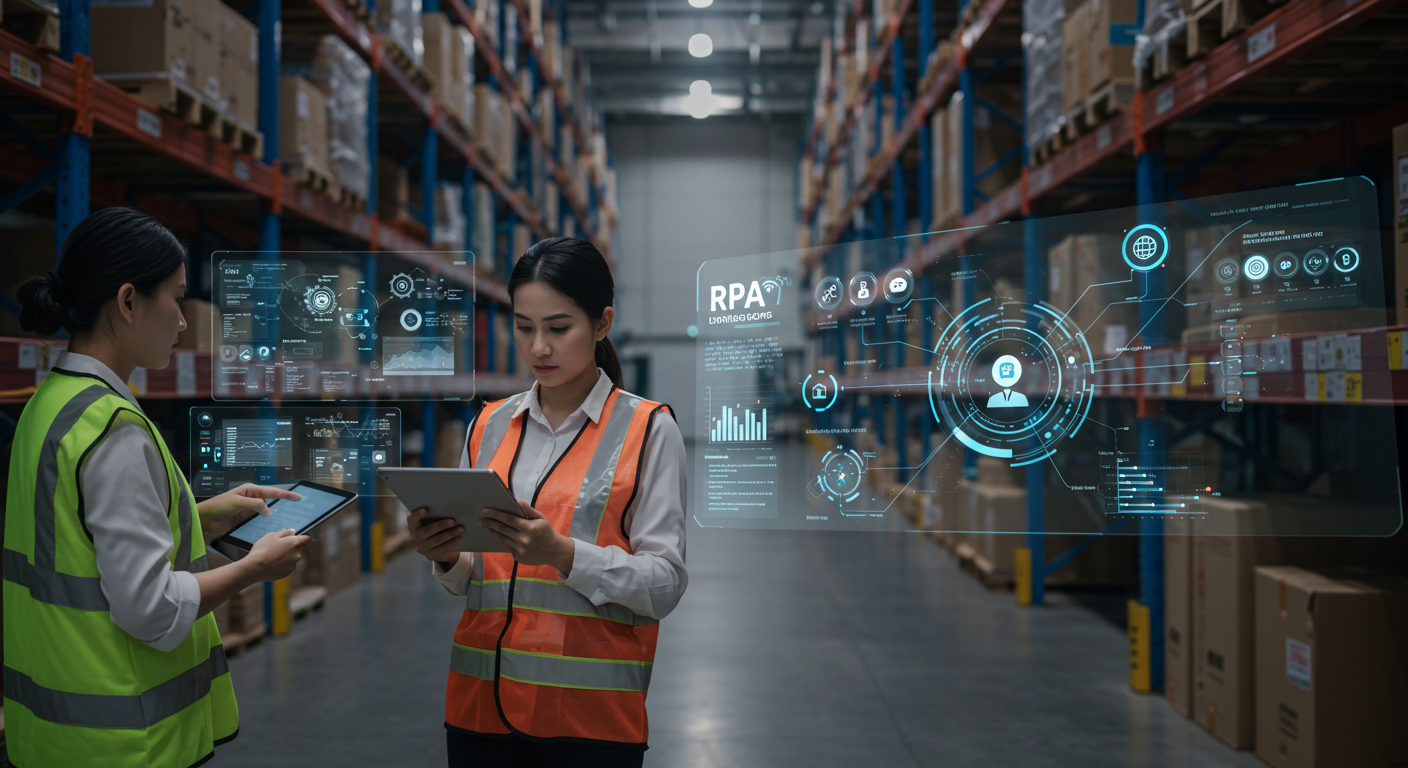Streamlined Inventory Management: The Role of RPA in Logistics
Supply chains break down. Orders get lost. Warehouses run out of stock. These problems happen every single day in logistics companies worldwide.
Manual processes create chaos. Workers spend hours typing data from one system into another. Mistakes pile up like shipping containers at a busy port. The global RPA market was valued at USD 28.31 billion in 2024 and shows no signs of slowing down. Companies need better solutions.
RPA in logistics offers a way out of this mess. Software bots work faster than humans. They never get tired. They don’t make typing errors when copying order numbers between systems. The technology transforms how businesses handle inventory, process orders, and track shipments.
Smart logistics companies are already seeing results. 25% of logistics businesses implemented RPA in 2024, ahead of other supply chain areas. These early adopters report fewer errors, faster processing, and happier customers.
Why Traditional Inventory Systems Create Problems
Warehouse managers know the pain. Systems that don’t talk to each other. Spreadsheets with outdated information. Workers who spend more time on data entry than on actual warehouse work.

The Hidden Costs of Manual Processing
Manual inventory management costs more than most companies realize. Workers need time to count products, update records, and generate reports. Each step creates opportunities for human error.
Think about a typical day in a distribution center. Someone receives a shipment and enters the quantities by hand. Another person picks items for orders and updates the system manually. A third worker processes returns and adjusts inventory levels one item at a time.
These repetitive tasks eat up labor budgets. Mistakes in inventory records lead to stockouts or overordering. Wrong inventory counts cause delivery delays. Customers get frustrated when their orders arrive late or incomplete.
When Systems Don't Communicate
Most warehouses use multiple software systems. The warehouse management system tracks inventory locations. The enterprise resource planning system handles purchasing. The transportation management system coordinates shipments.
These systems often work in isolation. Data gets trapped in silos. Workers become human bridges, manually transferring information between platforms. The process slows down operations and introduces errors at every handoff.
RPA in logistics and supply chain operations breaks down these barriers. Software bots move data seamlessly between different systems. They work 24/7 without breaks or sick days.
Breaking Free: How Automation Revolutionizes Warehouses
Modern warehouses need modern solutions. RPA transforms tedious manual work into smooth automated processes.
Digital Workers Take Over Repetitive Tasks
Software bots handle the boring stuff. They process incoming orders without coffee breaks. They update inventory records without typos. They generate shipping labels without complaints.
The difference is dramatic. Where a human might process 20 orders per hour, a bot can handle 200 orders at the same time. RPA reduces shipping errors by up to 80% compared to manual processing.
Here’s what happens when bots take over routine work:
- Order processing speeds up by 10x
- Data entry errors drop to near zero
- Inventory accuracy improves to 99%+
- Staff focus on problem-solving instead of paperwork
Real-Time Inventory Tracking Becomes Reality
RPA in logistics industry applications creates continuous monitoring systems. Bots check inventory levels every few minutes. They compare system records with actual warehouse activity. They spot discrepancies before they become problems.
Automatic alerts prevent stockouts. When inventory drops below preset levels, bots trigger reorder processes immediately. They don’t wait for someone to notice the shortage during a weekly review meeting.
The same system prevents overstocking. Bots analyze sales patterns and adjust reorder quantities accordingly. They consider seasonal trends, promotional activities, and supplier lead times when making decisions.
Integration Magic: Making Systems Work Together
RPA bridges the gap between incompatible systems. Bots log into each platform using standard interfaces. They extract data from one system and input it into another. The whole process happens without human intervention.
Consider a typical order fulfillment scenario. A customer places an order through the e-commerce website. The order management system receives the request. A bot pulls the order details and checks inventory availability in the warehouse management system.
If items are in stock, the bot creates picking instructions and updates the order status. It generates shipping labels and sends tracking information to the customer. The entire process takes minutes instead of hours.
Smart Inventory Strategies That Actually Work
Successful companies don’t just implement technology. They redesign their entire approach to inventory management.
Predictive Analytics Meet Automation
RPA for logistics goes beyond simple task automation. Advanced bots use historical data to predict future inventory needs. They analyze sales trends, seasonal patterns, and market conditions.
Machine learning algorithms improve predictions over time. The system learns from past forecasting errors and adjusts its models accordingly. Accuracy increases as more data becomes available.
This intelligence helps companies optimize their inventory investments. They carry less excess stock while maintaining high service levels. Working capital improves without sacrificing customer satisfaction.
Exception Handling Gets Smarter
Not everything goes according to plan. Suppliers deliver late. Customers change their minds. Products get damaged in transit. RPA systems handle these exceptions automatically.
Bots recognize unusual patterns in the data. They escalate complex issues to human workers while handling routine exceptions independently. The system learns which problems require human attention and which can be resolved automatically.
For example, if a supplier shipment arrives with quantity discrepancies, the bot compares the actual quantities with the original purchase order. Small variances get accepted automatically. Larger discrepancies trigger human review processes.
Multi-Location Inventory Optimization
Companies with multiple warehouses face complex balancing challenges. Stock levels need optimization across all locations. RPA systems coordinate inventory movements between facilities.
Bots analyze demand patterns at each location. They identify opportunities to redistribute inventory from slow-moving locations to high-demand areas. The system considers transportation costs and delivery time requirements when making transfer decisions.
This network-level optimization reduces total inventory investment while improving service levels. Customers get their orders faster because products are positioned closer to demand centers.

Implementation Roadmap: From Chaos to Control
Getting started with RPA requires careful planning. Companies that rush into automation often miss important opportunities or create new problems.
Phase One: Process Discovery and Mapping
Success starts with understanding current processes. Teams map out each step in their inventory management workflows. They identify bottlenecks, error points, and improvement opportunities.
Process mining tools help visualize actual workflows. These systems analyze log data from existing software to understand how work really gets done. The results often surprise managers who thought they knew their processes well.
Documentation becomes critical during this phase. Teams create detailed process maps that show:
- Current system inputs and outputs
- Decision points and business rules
- Error handling procedures
- Performance metrics and targets
Phase Two: Pilot Project Selection
Smart companies start small. They choose one or two processes for initial automation. The best candidates are high-volume, rule-based activities with clear success metrics.
Order processing makes an excellent first project. The workflow is well-defined. Success is easy to measure. Results become visible quickly to build organizational support for broader automation initiatives.
Inventory reconciliation represents another good starting point. The process involves comparing data between multiple systems. Manual reconciliation is time-consuming and error-prone. Automation delivers immediate benefits.
Phase Three: Bot Development and Testing
Development teams build the first automation workflows. They use specialized RPA platforms that provide drag-and-drop interfaces for creating bots. Programming skills help, but aren’t always required.
Testing happens in controlled environments before production deployment. Teams verify that bots handle normal workflows correctly. They also test exception scenarios to ensure proper error handling.
User acceptance testing involves the actual warehouse staff who will work alongside the bots. Their feedback helps refine the automation workflows before full deployment.
Phase Four: Scaling and Optimization
After successful pilot projects, companies expand automation to additional processes. They apply lessons learned from early implementations to new use cases.
Monitoring becomes essential during scaling. Performance dashboards track bot activity, error rates, and business outcomes. Teams use this data to optimize workflows and identify new automation opportunities.
Change management programs help staff adapt to their new roles. Training focuses on exception handling and bot maintenance rather than routine data entry tasks.
Looking Forward: The Evolution Continues
RPA in logistics keeps evolving. New capabilities emerge as technology advances and companies gain experience with automation.
Artificial Intelligence Integration
43% of manufacturers employed RPA in 2024, with another 43% planning new projects. The next wave combines RPA with artificial intelligence for more sophisticated automation.
AI-enhanced bots can read unstructured documents like emails and invoices. They extract relevant information without requiring standardized formats. Natural language processing enables bots to understand customer requests and routing instructions.
Computer vision technology allows bots to analyze images and videos. They can identify product damage, verify shipment contents, and monitor warehouse safety conditions. These capabilities extend automation beyond pure data processing tasks.
Cloud-Based Deployment Models
Over 20% of RPA initiatives migrated to cloud platforms by 2024, representing a massive increase from 1% in earlier years. Cloud deployment offers several advantages for logistics companies.
Scalability becomes easier when bots run in cloud environments. Companies can add processing capacity during peak seasons without hardware investments. They can also deploy automation to new locations without local infrastructure requirements.
Security improves through cloud provider investments in cybersecurity. Professional security teams monitor and protect RPA systems around the clock. Data backup and disaster recovery become automatic rather than manual processes.
Industry-Specific Solutions Emerge
Generic RPA platforms evolve into specialized solutions for logistics and supply chain management. These industry-specific tools include pre-built templates for common warehouse processes.
Integration becomes simpler with popular logistics software platforms. RPA vendors develop certified connectors for major warehouse management systems and transportation management platforms.
Best practice libraries help companies avoid common implementation mistakes. Industry-specific training programs reduce the time needed to develop internal RPA expertise.
The future belongs to companies that adapt quickly to changing technology landscapes. RPA provides the foundation for this adaptation by creating flexible, scalable automation platforms. Organizations that master these tools will gain sustainable competitive advantages in increasingly challenging logistics markets.
Early adopters already see the benefits. They process orders faster, maintain accurate inventory records, and satisfy more customers. As RPA technology continues advancing, these advantages will only grow stronger.